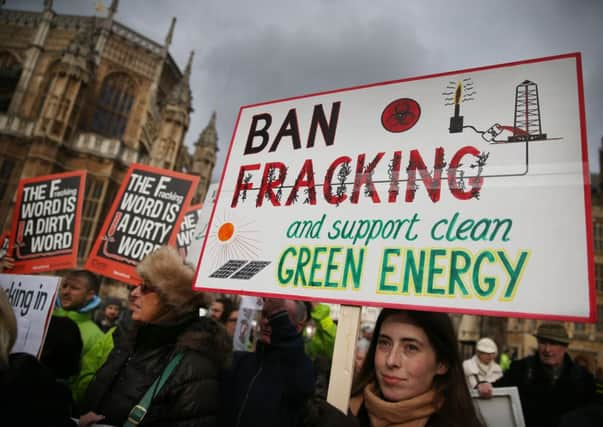Comment: Shale gas puts ‘tree-huggers’ to shame


Now, the latest focus for the green protesters and their celebrity backers is shale gas. Anti-fracking groups are mobilising across the UK, feverishly protesting that shale gas extraction will pollute our watercourses, cause massive earthquakes and disfigure the landscape. For the most part these protesters are Luddites, happy to vandalise our hills and glens with ugly industrial wind-turbines while arguing against relatively modest shale gas installations.
At the insistence of the Greens, the Smith Commission has agreed that control of fracking will become the responsibility of the Scottish Government. Jim Murphy has leapt on to the bandwagon, promising a total ban on fracking in Scotland if Labour wins the next Holyrood election. Now, in a desperate bid to outflank Labour and grasp the populist initiative, the SNP government has ordered an indefinite moratorium on planning consent for shale gas extraction in Scotland. It seems that only Conservative MSPs and MPs now back shale gas production.
Advertisement
Hide AdAdvertisement
Hide AdWe need a reality check. Ofgem, the energy regulator, has warned that the closure and mothballing of UK coal-fired power stations to meet EU 2020 CO2 emission targets is going to leave us perilously short of electricity within the next 18 months. Right now we have a 10 per cent surplus generating capacity, but by 2016 that will have fallen to only 3 per cent. Britain will be on a knife edge, teetering on the brink of blackouts.
Instead of properly dealing with this looming problem, policy-makers’ continuing obsession with renewable energy has seen more than 5,000 giant, industrial wind turbines installed from one end of the UK to the other – half of them in Scotland. Another 3,000 are in the planning pipeline. Sadly, due to their unreliability and the fact that they don’t work when there is no wind and have to be switched off when the wind is too high, they often produce only a trickle of the power we need.
Fearful that the successful exploitation of our massive shale gas reserves would render the entire wind industry obsolete, the green lobby is now in a blind panic, churning out endless lies about fracking and its alleged consequences. Fracking, or hydraulic fracturing, involves pumping thousands of litres of water mixed with sand, soap and citric acid into deep wells under high pressure. The mixture causes rock formations to fracture and release stored gases. The Americans have drilled tens of thousands of wells and conducted more than two million fracking operations without a single recorded incident of groundwater contamination or explosions. Boreholes for shale gas extraction commonly are drilled down to 2,000 metres or more underground, thousands of metres below the aquifer. The risk of water contamination is negligible.
With an estimated 200 trillion cubic feet of shale gas deposits discovered in Lancashire alone, enough to power Britain for 65 years, we could be looking at the biggest energy revolution since North Sea oil. The British Geological Survey suggests that UK offshore reserves could be five to ten times the size of onshore, perhaps in excess of one thousand trillion cubic feet, which would put the UK in the top 20 countries with shale gas reserves worldwide. Exploiting this resource will provide tens of thousands of jobs and slash energy bills.
Shale gas emits about half the CO2 that burning coal produces, which is why the US has managed to reduce its CO2 emissions by 450 million tonnes in the past five years, while EU and UK greenhouse gas emissions continue to soar. Carbon emissions in the US per capita are now below the levels they were in 1963, and meanwhile gas is at almost giveaway prices, kick-starting the US economy, boosting jobs and prosperity.
Already the shale gas revolution has shamed the wind industry by showing how to cut carbon emissions for real. We must stop the trendy protest army in its tracks and send them and their windmills packing. Shale gas could solve our looming energy crisis.
• Struan Stevenson was a Conservative Euro MP for Scotland from 1999 to 2014. He is the author of So Much Wind – The Myth Of Green Energy